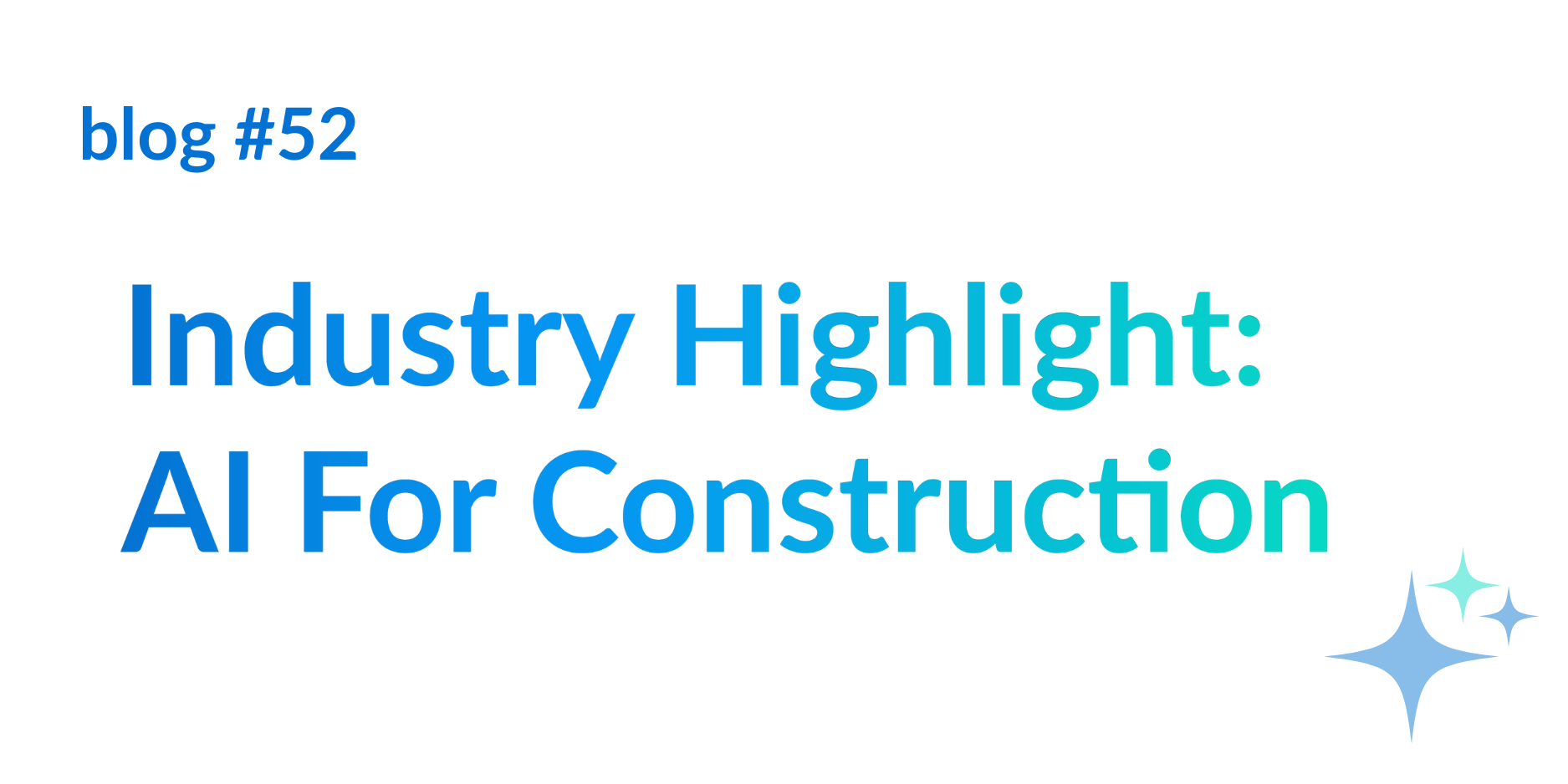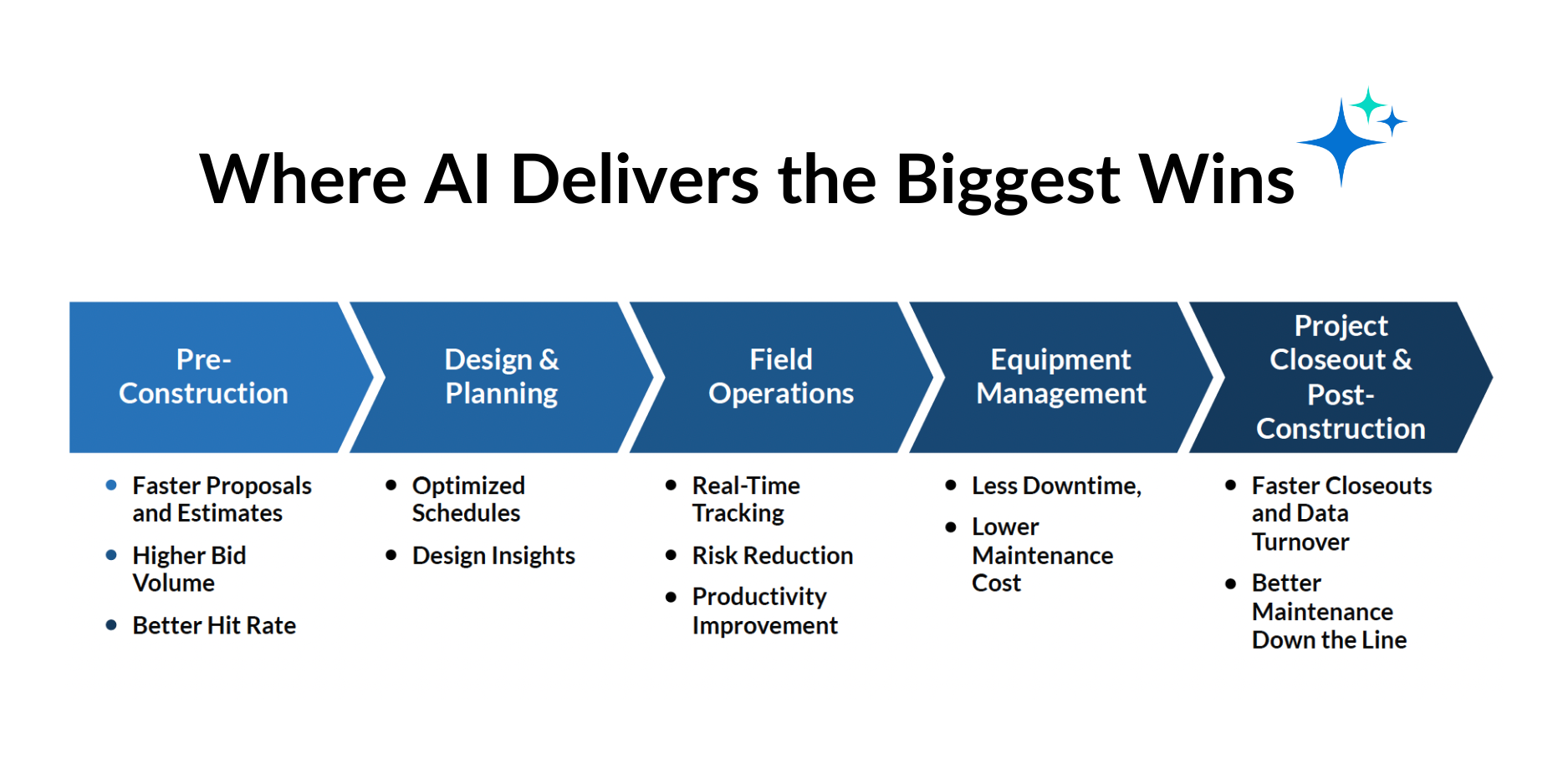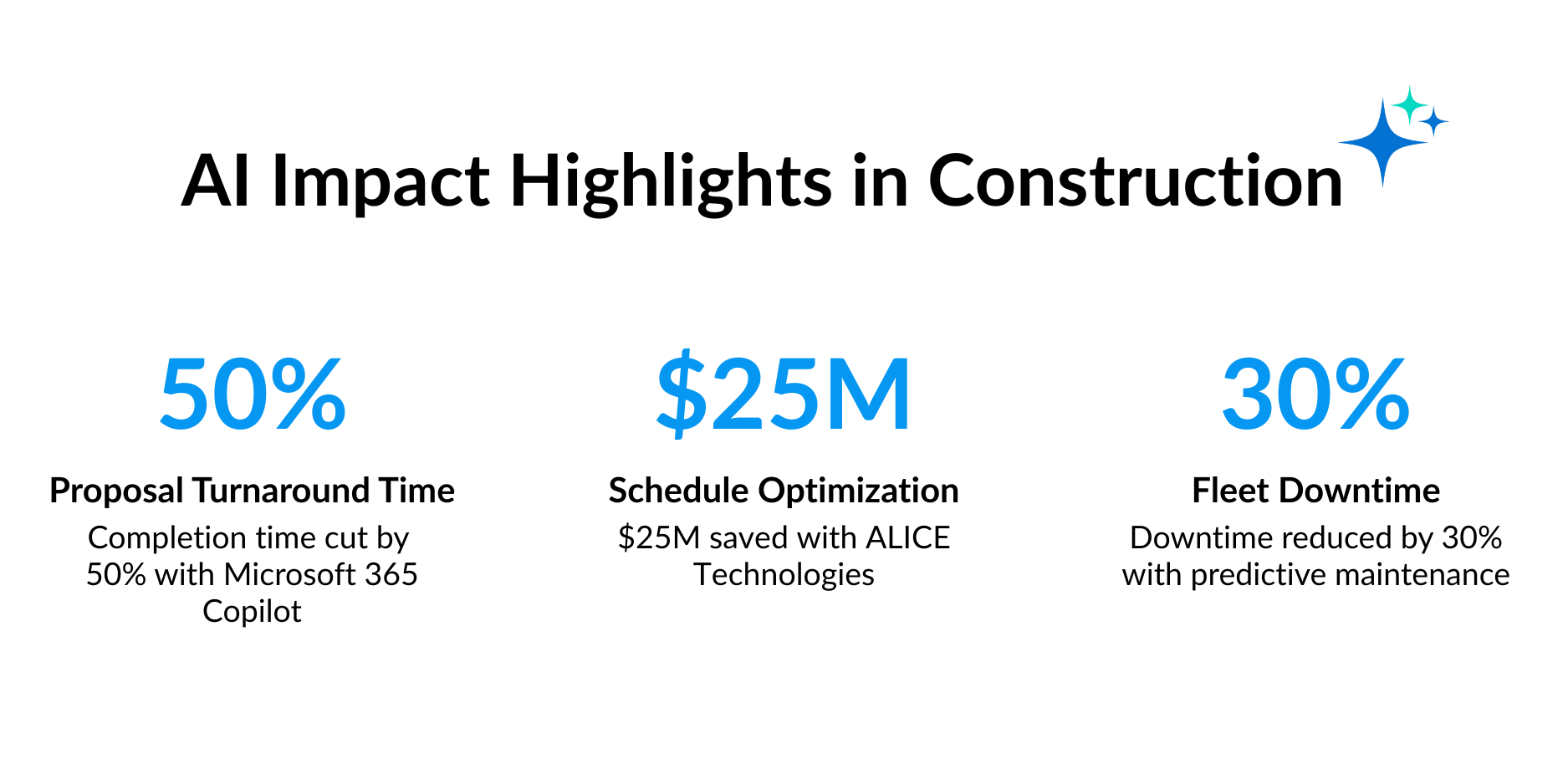
Contents
Construction firms investing in AI aren’t just improving operations — they’re winning more bids, retaining talent, and operating at a margin their competitors can’t match. The question isn’t whether to adopt AI — it’s how fast you’re moving before the gap becomes permanent.
Faced with shrinking margins, labor shortages, project delays, and safety concerns, firms of all sizes—from independent contractors to global builders—are turning to AI to boost productivity, improve safety, and drive profitability. And it’s paying off. These tools are already delivering measurable results—like saving over 14,000 labor hours and cutting $1 million in annual costs—without reinventing the wheel.
In this article, we’ll highlight the most impactful ways AI is transforming the construction industry, address common concerns, and provide a practical roadmap with steps to help you get started.

Where AI Delivers The Biggest Construction Wins
AI is rapidly becoming one of the most valuable tools in a construction firm’s arsenal—not as a vague promise, but as a practical driver of speed, precision, and profitability. Even small gains in efficiency can translate into significant bottom-line impact. Whether you're aiming to win more bids, streamline field operations, or optimize equipment usage, AI is delivering measurable improvements across the entire project lifecycle. Here's where the biggest wins are happening today.
Pre-Construction
In pre-construction, speed and precision are everything—and this is where AI delivers immediate value. By automating tasks like lead qualification, proposal writing, quantity takeoffs, and cost estimation, AI helps teams respond to more bids in less time. For example, one construction company used Microsoft 365 Copilot to cut proposal creation time in half, while another, Coastal Construction, used Togal.AI deep-learning technology to asses and measure project spaces. The result? Higher bid volume, faster turnaround, and better win rates. AI turns proposal bottlenecks into business advantages—giving firms a smarter, faster path to winning work without overloading their teams.
Design & Planning
Next up is the critical phase of design and planning, which encompasses early design, coordination, model analysis, constructability reviews, and scheduling. This stage is where AI is delivering significant value through optimized scheduling and insightful design analysis. For example, ALICE Technologies has proven its value on major highway projects by rapidly generating and evaluating thousands of schedule scenarios—helping teams reduce delays, optimize resources, and ultimately save a highway contractor over $25 million. Beyond scheduling, AI is increasingly used for clash detection, generative design, and analyzing BIM models to predict cost or risk hotspots. Many general contractors are leveraging AI tools to enhance design coordination and minimize change orders, ultimately driving smoother project delivery with fewer surprises.
Field Operations
In the build phase—where project management, site coordination, and safety intersect—AI is transforming how teams operate on the ground. Real-time data tracking boosts productivity and minimizes human error, while AI-powered dashboards can detect early signs of schedule slippage or budget overruns before they escalate. The results are already tangible. On a recent medical office project, Doxel’s autonomous AI robots conducted daily scans to catch plan deviations early, keeping the project on track and ahead of delays. Meanwhile, tools like Motive are using AI to analyze live webcam footage and proactively flag safety risks—helping prevent incidents before they happen. The bottom line? AI empowers field teams with real-time visibility and early warnings—so projects run smoother, safer, and with fewer costly surprises.
Equipment Management
On any active jobsite, keeping equipment running reliably is mission-critical—and AI is making that easier than ever. Predictive maintenance powered by AI helps identify mechanical issues before they lead to costly breakdowns, minimizing downtime and extending the life of key machinery. A standout example is HVI’s use of AI to reduce fleet downtime by 30%, keeping projects on schedule and costs in check. But AI’s impact doesn’t stop with equipment. It’s also transforming materials management—forecasting demand, tracking price trends, and even optimizing delivery schedules. Some firms now use AI to manage inventory in real time, ensuring critical materials are always on hand. These kinds of behind-the-scenes efficiencies often go unnoticed, but they make a big difference—keeping crews productive, avoiding delays, and improving overall jobsite performance. With AI, managing the equipment and materials your team depends on becomes easier, more predictable, and far less likely to slow you down.
Project Closeout & Post-Construction
AI plays a valuable role in the project closeout and post-construction phase. This includes handover, the warranty period, and, in some cases, ongoing facilities management for the owner. AI can streamline these processes by accelerating closeouts and improving data turnover. For example, AI tools can organize and tag project documents, verify that as-built drawings reflect actual site conditions—especially when solutions like Doxel are used during construction—and create a rich, searchable digital record. The long-term benefits include simplified documentation handover, more effective maintenance planning, and better benchmarking for future projects.

Addressing 3 Common Concerns
The construction companies that hesitate to adopt AI typically do so because they think it’s only for big tech firms or huge organizations. But the truth is, AI tools today are more accessible and adaptable than ever, designed to support construction teams of all sizes and specialties. With a growing range of off-the-shelf solutions and resources available, starting your AI journey is more achievable than you might expect. Let’s explore some common concerns and show why AI is truly within your reach.
- Cost: It’s a common misconception that AI implementation requires a massive upfront investment. In reality, many AI tools offer flexible pricing models and can be deployed incrementally, allowing companies to start with small pilots that deliver quick wins. By targeting high-impact areas first, companies can realize cost savings and efficiency gains that often-offset initial expenses. Over time, these improvements translate into significant ROI.
- Technical: Many construction leaders hesitate to adopt AI, thinking it requires coders or a large IT team—but that’s no longer the case. Today’s off-the-shelf AI tools are built for ease of use, with intuitive interfaces designed for field teams. With proper training and implementation, even non-technical staff can quickly become proficient and see immediate efficiency gains.
- Change: The fear of change is real and understandable. But the most forward-thinking firms aren’t overhauling everything overnight; they’re starting small. Piloting one AI tool in a specific part of the workflow—like estimating or equipment maintenance—lets teams see tangible results without overwhelming them. As those wins build, so does confidence across the organization, paving the way for broader adoption and long-term impact.
Getting Started With AI
Achieving meaningful results with AI requires more than simply introducing a new tool and hoping it gains traction. Organizations that generate real value from AI do so through a thoughtful combination of strategy, intentional execution, and committed leadership. In our experience, successful AI implementation consistently hinges on three key elements: a well-defined strategy, use case–driven training, and clear leadership accountability.
Importantly, if your internal team is not yet equipped to lead the organization through AI-related strategy, training, and transformation, partnering with a specialized AI consultancy is more effective than a do-it-yourself approach. The right AI partner can accelerate progress, avoid costly missteps, and ensure that AI efforts align with broader business objectives from the outset.
- Identify Pain Points: Begin by analyzing where your processes face the most friction—this could be delays, rework, cost overruns, or inefficiencies. A clear understanding of these challenges sets the foundation for targeted, high-impact AI applications.
- Assess Impact vs. Effort: Not all AI initiatives are created equal. Start with low-effort, high-impact opportunities—what we call "quick wins"—to demonstrate early value and gain internal momentum.
- Build a Roadmap: Develop a phased implementation plan that aligns with your business goals. Assign clear ownership, establish KPIs, and allocate time for team training and change management.
- Select & Execute: With a roadmap in place, move forward with disciplined execution. Monitor progress, capture learnings, and iterate as needed to ensure long-term success and scalability.
Ready to start your AI journey? Begin by taking our free AI Readiness Assessment to gauge your team’s level of AI preparedness. It’s a great first step to understand what needs to happen before diving in. Alternatively, if you're confident in your organization’s ability to move forward but need expert guidance along any aspect of your AI Journey, we’ve got you covered! Schedule a meeting with me to get the conversation started. Together, we can transform the complexities of operational success into opportunities for growth and prosperity.



